| Columns Retired Columns & Blogs |
..counts less than the specific implementation proper.
When Art Dudley wrote about Luxman's MQ-88uSE power amplifier in his September 2018 "Listening" column, he was impressed by what he heard from this classic, well-made tube design driving DeVore Fidelity Orangutan O/93 loudspeakers. He concluded his review by saying, "As for the brilliantly musical and unmistakably high-value Luxman MQ-88uSE, you might want to grab one while you can" (footnote 1). While visiting Art's place in upstate New York last June to pick up the Kalista CD player featured on the September issue's cover, I picked up the Luxman amplifier and took it back to my place, to perform on it a full set of measurements.
I measured the Luxman MQ-88uSE using my Audio Precision SYS2722 system (see the January 2008 "As We See It"). I mostly used the Direct inputs, but repeated some tests via the Variable inputs, whose circuits include the front-panel volume control. The Luxman amplifier has a single set of output transformer taps, which the manual states are optimized for 6 ohm loads. The voltage gain into 8 ohms was close to the specification but a little on the low side, at 24dB. Both sets of inputs preserved absolute polarity (ie, were non-inverting); for the Direct inputs, the input impedance, specified as 100k ohms, was 54k ohms at 20Hz and 1kHz, dropping slightly to 42k ohms at 20kHz; and, for the Variable inputs, 34k ohms at 20Hz and 1kHz, dropping to 28k ohms at 20kHz.
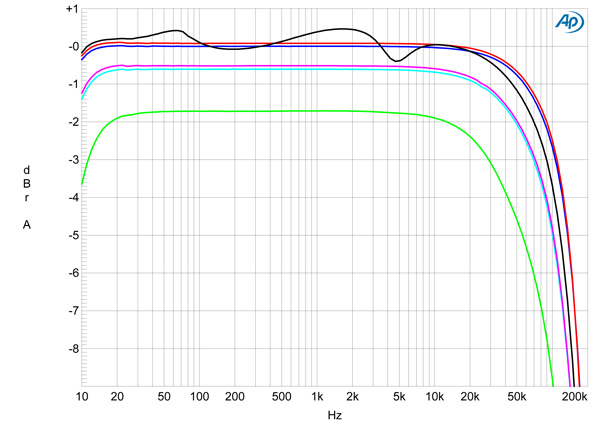
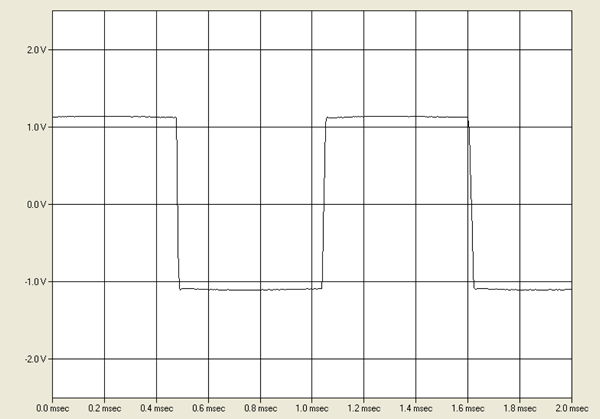
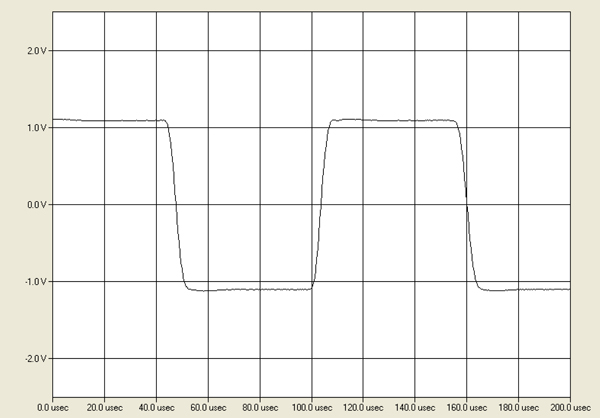
The output impedance, including a 6', spaced-pair speaker cable, was relatively low for a design using a single pair of KT88 tubes—props to Luxman for including a schematic in the manual!—at 0.6 ohm at 20Hz and 1kHz, rising to 0.75 ohm at 20kHz. As a result, the modulation of the Luxman's frequency response with our standard simulated loudspeaker was ±0.4dB (fig.1, gray trace). The response into 8 ohms was flat to 20kHz (blue and red traces), and only slightly less extended into lower impedances (cyan, magenta, green). The MQ-88uSE's reproduction of a small-signal 1kHz squarewave into 8 ohms was excellent (fig.2), the flat tops confirming the extended low frequencies seen in fig.1. A 10kHz squarewave (fig.3) featured short risetimes, with no overshoot or ringing evident. The Luxman's squarewave performance is a tribute to the high quality of its output transformers.
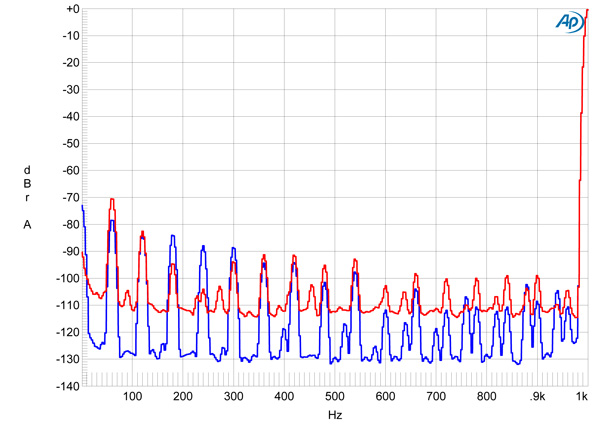
Channel separation was asymmetric, measuring >80dB below 1kHz, R–L, but 62dB, L–R. Though the levels of power-supply–related spuriae were the same in both channels (fig.4), the right channel also had a higher level of random noise than the left. The unweighted, wideband signal/noise ratio, taken with the inputs shorted to ground, was 79.1dB for the left channel but 74.8dB for the right, both ratios ref. 1W into 8 ohms. The S/N ratio improved to a very good 87.6dB with an A-weighting filter in circuit.
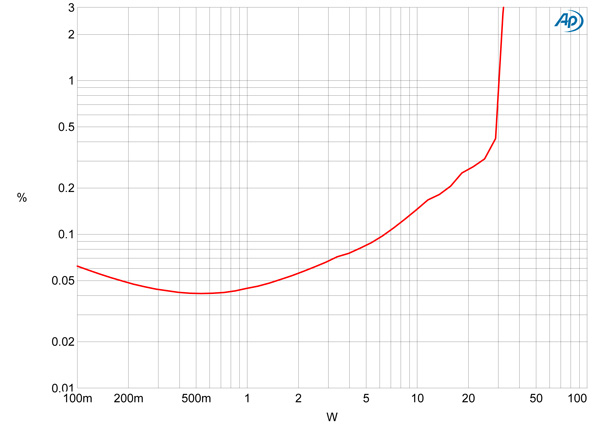
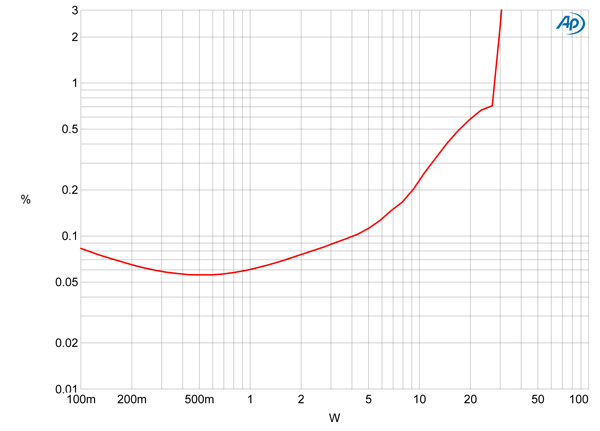
Luxman specifies the MQ-88uSE as offering 25Wpc into 6 ohms (12.2dBW), and 20Wpc into 8 ohms (13dBW) and 4 ohms (10dBW). Defining clipping as when the proportion of THD+noise in the output reaches 1%, I measured clipping powers of 30W into 8 ohms (14.8dBW, fig.5) and 28Wpc into 4 ohms (11.5dBW, fig.6), both with both channels driven. Figs. 5 and 6 indicate that the Luxman amplifier has low distortion at powers below 1W.
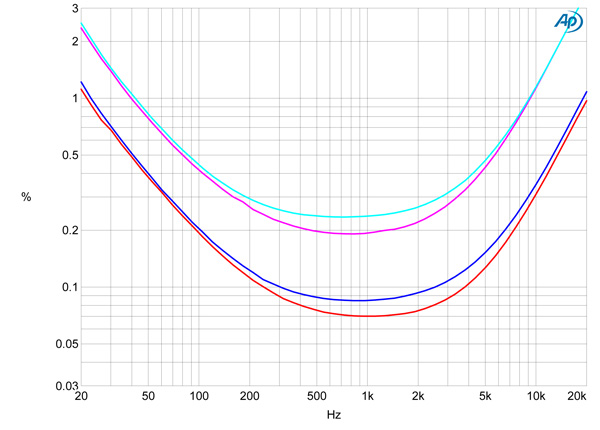
I examined how the MQ-88uSE's percentage of THD+N varied with frequency at 6.35V (equivalent to 5W into 8 ohms and 10W into 4 ohms). The THD+N was relatively low in the midrange into 8 ohms (fig.7, blue and red traces), but rose both into 4 ohms (cyan, magenta) and at the frequency extremes.
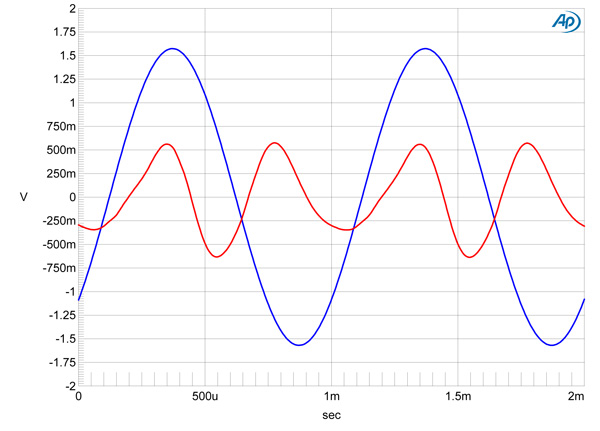
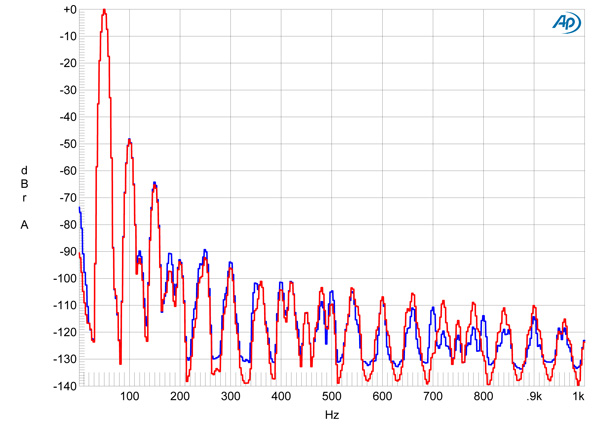
The THD+N waveform at 10Wpc into 8 ohms (fig.8) indicates that the distortion signature is primarily second harmonic in nature. Spectral analysis of the amplifier's output while it drove 50Hz at 5Wpc into 8 ohms (fig.9) shows that the third harmonic is also present at a lower level than the second, and that higher-order harmonics are also present, though these lie at or below –90dB (0.003%). Tested with an equal mix of 19 and 20kHz tones with the signal peaking at 5Wpc into 8 ohms, the Luxman produced relatively low levels of high-order intermodulation distortion, though the difference product at 1kHz was fairly high in level, at –52dB (0.25%, fig.10).
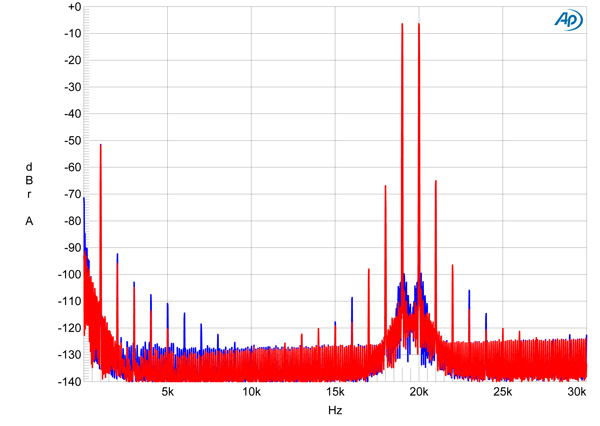
When measuring tube amplifiers, I'm leery—too often, there are idiosyncrasies that demand further, time-consuming investigation. But all went well with Luxman's MQ-88uSE. It is an excellent example of a classic push-pull tubed design.—John Atkinson

..counts less than the specific implementation proper.

It is a beam tetrode; the KT means "Kinkless Tetrode".
With all the "technical detail" you go into, I'd think you could get this basic detail right.

Hi
When KT-88 is hooked as a pentode with standard push-pull (non-ultra linear) output mode, its Ip-Vp transfer curves are KINKED.
It got to be hook up as pentode mode at high Vp to enable to use such very high fixed bias voltage -45V or higher.
So Art was correct to say KT-88 is a pentode in this situation.
Jack L.
Canada

Thank you for the review. I'll never own one of these (kids in college) but it's still great to read about the products from such a classic brand. Their amps are always just so smooth and musical. I have a circa 1982 L-580 integrated and it still sounds beautiful. Maybe a little dark and rolled off but it just makes music.

I was happy even looking at the pics.

I agree!
Over the past couple months, I've read loads of articles about audio and audio equipment. Almost all ended up being contentiously commented on. OK, nobody says that's not allowed. But, it's not exactly cheery.
On the other hand, the couple I've read that were written by Art Dudley about this kind of product have always left me happy. *That* is cheery.

... 100w power rating, and it typically does closer to 140W.
It also has an excellent phono amp, with a separate MC pre-preamp.
If you haven't done so already, it would be worthwhile to have the 50, or so, electrolytic capacitors replaced. Also, several of the transistors in the power amp section run too hot, so that should be addressed, as well.
http://www.tapeheads.net/showthread.php?t=28573

Yes, that's the one. The large power caps were upgraded when I purchased it 10 years ago or so. It's in my secondary system now so probably won't do further upgrades but agree with you - it's very powerful and has a nice, rich, warm sound. I know that "Tapeheads" article detailing the restoration of that model and it's great. The restorer loved the sound of the amp.

... dynakitparts for a mere $600:
https://www.dynakitparts.com/shop/st-35-kit-120-vac/

They are charging for the looks and the name of the company :-) .........

With all the proprietary parts and hand assembly...not to mention the thought of the company turning a profit to pay it's workers. That's a very nice looking piece that seems like a very solid performer...something the company should be proud of. I was rather shocked to see the US corporate office almost in my back yard, of all places.

Dear Art, here in Italy Luxman MQ-88uSE is sold only in a bundle with its pre-amplifier companion Luxman CL-38uSE that also has an interesting phono MM/MC. It could be interesting to know your opinion about the couple, maybe with a little listening-review, and, in this case to know differences between you reference pre and the Luxman pre. Any possibility?

"Luxman MQ-88uSE runs its output tubes as triodes, not pentodes. These tubes must be stupid: They don't know they're supposed to be slow and temporally imprecise when used as triodes." quoted Art Dudley.
This is the tonal characteristic of any triode-converted pentode using a resistor: relatively slow, soft, lacking punch vs its pentode configuration.
Decades long established audio amp. manufacturers, like Lux, Japan still sticks to the old-old-school design of triode strapping with a resistor. What a shame !
That said, if a pentode is properly converted to a triode using some new school type topology, it will sound fast, punchy like a pentode. I design-built a few such conversions with good success many years since.
Instead of using a resistor strapping the screen grid of the pentode directly to its plate like many amp manufacturers, including Lux, did in the past, which sounds slow & punchless, I have used a new topology, which I called it "Plate-screen split potential topology".
Instead of using a resistor so simple, the topology requires strapping the screen grid of the pentode to its plate with a circuitry of high quality capacitors, resistors & diodes, providing a STABILIZED potential difference between the plate & the screen grid. With the right split potential, the trioded pentode will sound superb:- faster, more detailed, more transparent than & as powerful as its pentode mode !
The 'trick' is to choose what right potential split ! I experimented quite a while until I found the right plate-screen voltage split. The superb sound of such triode conversion is very rewarding.
My first successful triode conversion was done on my vintage Dynaco ST-70 power amp many years back. I installed the pentode-triode split-potential conversion of EL-34 push-pull output power tubes. With a pair of toggle switches, I can switch back & forth pentode-triode modes.
Such split-potential triode mode sounds so much better than its original pentode output mode in term of speed, transparency & delicacy. I would never want to go back to the pentode mode again.
Listening to believing
Jack L.
Canada

I'm a little late to this conversation, but I could not pass up a great deal a few months ago on a new one of these amps, and it's just now broken in. Art didn't get into this much in his review, but the Variable mode can be used to connect a source component directly into the amp using the attenuator on the front panel (so it seems like this should be the Direct mode, but it's just the opposite). I've done this with my CD player (Naim), analog front end (Rega 10, Benz Ruby Z and Musical Surroundings phono pre/Auditorium step-up), and my oldie but goodie Yamaha tuner. IMO, they are all more satisfying this way as opposed to going through my Shindo preamp. Now don't get me wrong, my Monbrison (the original, not the newer one) is wonderful, and it's more convenient using the preamp (you can only connect one source at a time using Variable mode.) But used with this option, I think this amp might be even better than Art says it is, and he really liked it. And thanks Art, you have never led me astray.